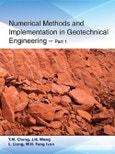Numerical Methods and Implementation in Geotechnical Engineering explains several numerical methods that are used in geotechnical engineering. The first part of this reference set includes methods such as the finite element method, distinct element method, discontinuous deformation analysis, numerical manifold method, smoothed particle hydrodynamics method, material point method, plasticity method, limit equilibrium and limit analysis, plasticity, slope stability and foundation engineering, optimization analysis and reliability analysis.
The authors have also presented different computer programs associated with the materials in this book which will be useful to students learning how to apply the models explained in the text into practical situations when designing structures in locations with specific soil and rock settings.
This reference book set is a suitable textbook primer for civil engineering students as it provides a basic introduction to different numerical methods (classical and modern) in comprehensive readable volumes.
Table of Contents
Chapter 1 Introduction
1.1. Introduction
1.2. More Problem Cases From Slope Stability Analysis
1.2.1. a Slope With a Soft Band
1.3. Strange Results From Mesh Refinement
1.4. Governing Equations for Some Engineering Problems
1.5. Closed-Form Solutions
1.6. Layout of This Book
Chapter 2 Numerical Methods in Geotechnical Engineering
2.1. Introduction To Programming
2.1.1. Management of Input Data
2.1.2. Some Geometry File
2.1.3. Mesh Generation
2.2. Introduction To Finite Element Analysis
2.2.1. Plane Strain
2.2.2. Plane Stress
2.2.2.1. Relationship Between Plane Strain and Plane Stress
2.2.3. Fundamentals of Fem
2.2.4. Principle of Virtual Displacement
2.2.5. Principle of Minimum Potential Energy (PMPE)
2.3. General Expressions and Implementation Procedure of FEM
2.3.1. Discretization of Domain
2.3.2. Interpolation Or Displacement Model
2.3.3. Stiffness Equilibrium Equation (See) of Fem Derived From PMPE
2.3.4. Derivation of Element Stiffness Matrices (ESM)
2.3.5. Assembling of Esms and Enlms
2.3.6. Isoparametric Element and Numerical Integration
2.3.6.1. Derivative and Integral Transformation
2.4. Development of a Pseudo 8 Node Mindlin Quadrilateral Plate Element
2.4.1. Formulation of a New Shear Deformable Beam Free From Shear Locking
2.4.2. Formulation of Rectangular Shear Deformable Plate Based on Shear Deformable Beam
2.4.2.1. Formulation of the Shear Stiffness Matrix of the Thick Plate Element
2.4.2.1.1. Transverse Shear Strain at Sides of Element
2.4.2.1.2. Shear Strain Within Element
2.4.2.1.3. Formulation of the Stiffness Matrix of the Thick Plate Element
2.4.3. Extension To General Quadrilateral Plate Element
2.4.4. Structure of Program Plate As Given in Appendix 2-4
2.4.5. Numerical Implementation of Mindlin Plate Bending Program
2.4.6. Development of a Pseudo 9 Node Mindlin Quadrilateral Plate Element
2.4.6.1. Shear Stiffness Matrix
2.4.6.2. Bending Stiffness Matrix
2.4.7. Extension of “Plate-Q9” To General Quadrilateral Element
2.4.8. Performance of the “Plate-Q9” Demonstrated by Numerical Examples
2.4.9. Patch Test for Plate-Q9
2.4.9.1. Pure Bending Patch Test
2.4.9.2. Patch Test for Shear
2.4.9.3. Patch Test for Shear and Bending
2.4.9.4. Patch Test for Twist
2.5. Final Discussion
Chapter 3 Plasticity, Limit Equilibrium and Limit Analysis Methods In Geotechnical Engineering
3.1. Introduction To Ultimate Limit State Analysis
3.2. Slip-Line Method
3.2.1. Slip-Line Method for Plane Strain Problem
3.2.1.1. Boundary Conditions in a Bearing Capacity Problem
3.2.1.2. Boundary Conditions for a Lateral Earth Pressure Problem
3.2.2. Slip Line Analysis for Axi-Symmetric Problem
3.2.2.1. Steps for Solution
3.2.3. Discussion on Slip Line Analysis
3.3. Introduction To Limit Equilibrium Method
3.3.1. Definition of the Factor of Safety for Slope Stability Analysis
3.3.2. Formulation of Limit Equilibrium Methods
3.3.3. Interslice Force Function
3.3.4. Discussion on the Interslice Force Function
3.4. Unification of Bearing Capacity, Lateral Earth Pressure And Slope Stability Problems
3.4.1. Discussion on Unification of Stability Analysis Methods
3.5. Limit Analysis Method
3.5.1. Lower Bound Approach
3.5.2. Upper Bound Approach
3.5.3. Lateral Earth Pressure Coefficients by Limit Analysis
3.6. Limit Analysis Method - Dlo
3.6.1. Discontinuity Layout Optimization
3.6.2. Some Studies on Discontinuity Layout Optimization
3.7. Overall Discussion
Appendix
Appendix 2-1. Illustration of Refine Input Format by a Grid Analysis Program.
Appendix 2-2. a Simple Two-Dimensional Mesh Generation Program
Appendix 2-3. Bandwidth/Profile Minimizer
Appendix 2-3.1. Functions of Some Subroutines
Appendix 2-3.1.1. Subroutine Array
Appendix 2-3.1.2. Subroutine Genrcm (General Rcm)
Appendix 2-3.1.3. Subroutine Fnroot (Find Root)
Appendix 2-3.1.4. Subroutine Rootls (Rooted Level Structure)
Appendix 2-3.1.5. Subroutine Rcm (Reverse Cuthill-Mckee)
Appendix 2-3.1.6. Subroutine Degree
Appendix 2-4. Thin and Thick Plate Finite Element Program
Appendix 2-5. One-Dimensional Consolidation
Appendix 2-6. Extension To Two and Three - Dimensional Biot Consolidation
Appendix 3-1 - Lateral Earth Pressure Slip Line Program Ka
Appendix 3-2 - Program Lep for Limit Analysis
Appendix 3-3-Axi-Symmetric Lateral Earth Pressure Slip Line Program
Samples

LOADING...
Author
- J. H. Wang
- Li Liang
- W. H. Fung Ivan
- Y.M. Cheng








